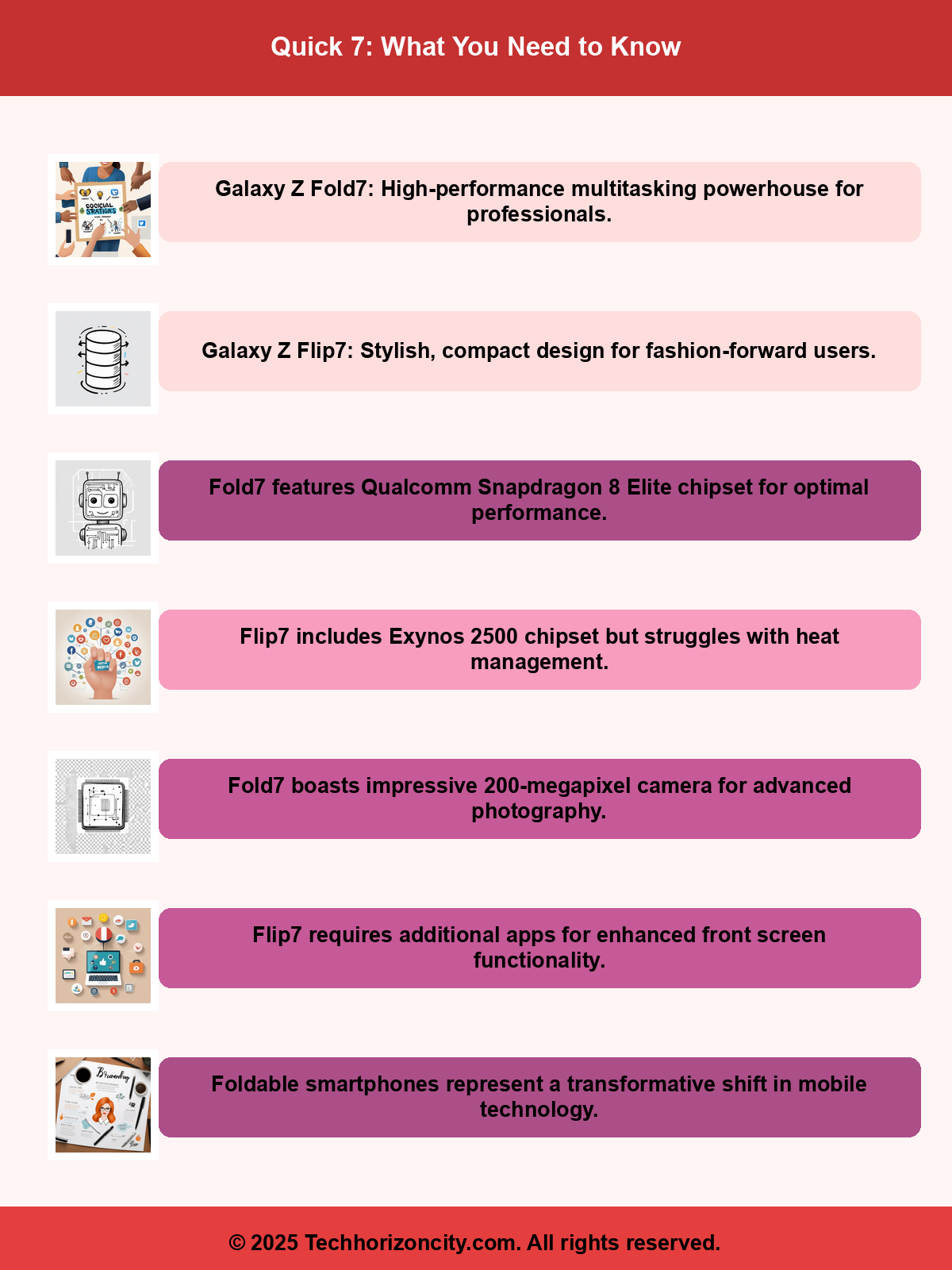Executive Summary
Samsung’s latest releases, the Galaxy Z Fold7 and Galaxy Z Flip7, represent significant advancements in foldable smartphone technology. With the introduction of enhanced features such as powerful chipsets and improved camera capabilities, these devices highlight Samsung’s commitment to innovation in the competitive smartphone landscape. While the Fold7 appeals to users seeking productivity and advanced photography, the Flip7 targets those who prioritize portability and style. However, issues such as heat management in the Flip7 could affect user experience. This analysis delves into the implications of these advancements for consumers and the broader industry, offering a forward-looking perspective on the future of foldables.

Background Context
The smartphone industry has seen a transformative shift with the introduction of foldable devices, which offer a unique blend of portability and functionality. Samsung, as a pioneer in this space, has leveraged its extensive experience in mobile technology to release the seventh generation of its folding phones. The Galaxy Z Fold series has always aimed to cater to users who require a multitasking powerhouse, while the Z Flip series focuses on a sleek, compact design that appeals to fashion-forward individuals. With the Fold7 housing a Qualcomm Snapdragon 8 Elite chipset and boasting a remarkable 200-megapixel camera, it undeniably raises the bar for performance and imaging quality. Conversely, the Flip7, equipped with the Exynos 2500 chipset and featuring a 50-megapixel camera, emphasizes style but faces some performance hurdles, particularly with heat management during intensive tasks.
For technical resources and innovative solutions, please visit EchoesOfCreationUS for specialized technical resources.
Analysis of Implications
The contrasting features of the Fold7 and Flip7 present an interesting dichotomy in consumer choice. The Fold7’s high-performance specifications cater to professionals and creatives who leverage mobile devices for intricate tasks. Its impressive camera and larger screen real estate facilitate productivity, allowing users to run multiple applications concurrently. This capability could make it a favorite among business users and content creators who require efficient multitasking.
On the other hand, the Flip7 appeals to a demographic that values aesthetics and convenience. Its compact design and fashionable appearance make it an attractive accessory rather than just a communication tool. However, the need for additional apps like Multistar to enhance functionality on the front screen indicates a potential limitation in user experience. Furthermore, the heating issue associated with the Exynos 2500 chipset raises concerns about long-term usability, which might deter some potential buyers. It suggests that while the Flip7 excels in design, its performance may not meet the expectations of all users, particularly those who rely heavily on their smartphones for demanding applications.
Discover exclusive offers and premium content at Active Living Offers – your gateway to enhanced productivity and lifestyle solutions.
Industry Impact Assessment
Samsung’s foray into the seventh generation of foldable devices underscores a broader trend within the smartphone industry: the shift towards versatile, multi-functional devices. As competitors strive to catch up, the innovation showcased in the Fold7 and Flip7 may compel them to rethink their strategies, focusing not just on traditional features but also on how to integrate foldable technology effectively.
Moreover, the advancements in camera technology and processing power in the Fold7 could set a new standard for premium smartphones across the board. As consumers increasingly prioritize photography and video capabilities, manufacturers will need to push the envelope further, not only to match Samsung’s offerings but also to differentiate their products in a crowded marketplace. This competition could lead to rapid advancements and further innovations in foldable designs, materials, and technology.
Future Outlook
Looking ahead, the future of foldable smartphones appears promising, albeit with some challenges. As manufacturers continue to refine their foldable offerings, we may see enhancements in durability and performance across the board. The demand for versatile devices that provide both functionality and portability is likely to increase, as more users seek out technology that adapts to their lifestyles.
Samsung’s approach with the Fold7 and Flip7 could inspire future iterations with even more capable chipsets, improved thermal management, and enhanced user interfaces that streamline multi-tasking without compromising battery life. Additionally, as consumers become more tech-savvy, there may be a growing expectation for seamless integration across devices, prompting manufacturers to consider their ecosystem strategies more seriously.
Conclusion with Key Takeaways
In summary, Samsung’s Galaxy Z Fold7 and Galaxy Z Flip7 highlight the company’s ongoing commitment to innovation in the foldable smartphone market. The Fold7 stands out for its impressive performance and capabilities, making it ideal for power users, while the Flip7 attracts those who prioritize design and portability, despite some drawbacks in heat management and app functionality. As competition in the industry intensifies, the advancements made by Samsung may spur further innovation, pushing other companies to enhance their offerings in both foldable and traditional smartphone markets.
Key takeaways include:
- The Fold7 is a game-changer for productivity and photography enthusiasts.
- The Flip7 caters to style-conscious consumers, but faces performance challenges.
- The advancements in foldable technology will likely influence future smartphone designs across the industry.
Disclaimer: This article was independently created based on publicly available information and industry analysis.
